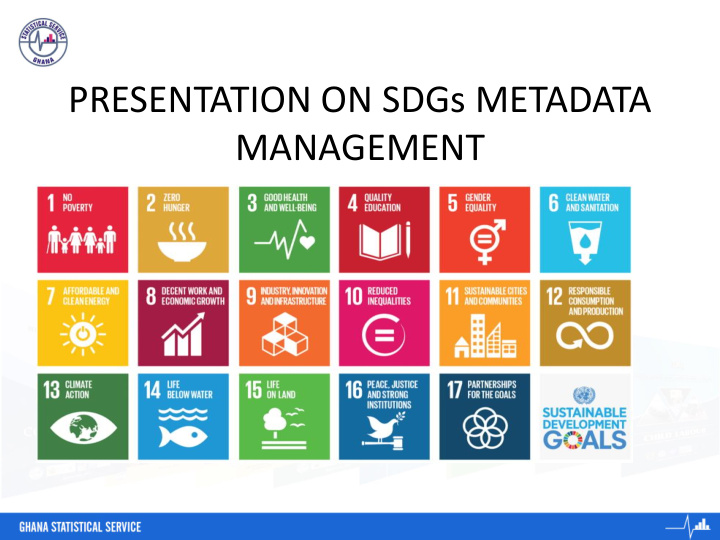



PRESENTATION ON SDGs METADATA MANAGEMENT
INTRODUCTION To fulfill the commitment to “Leave No One Behind” on which Agenda 2030 (SDGs) is based, require robust data production and tracking systems to be built so that achievements at the national and local levels can be assessed and fed into the wider global framework. Harnessing new data sources and integrating them into official statistics is key to ensure adequate supply of data to measure the SDGs .
NATIONAL CAPACITY ASSESSMENT 3
MEETING WITH STAKEHOLDERS WITHIN THE NSS To ensure improved method for data collection and analysis that will reduce data gaps and provide a sound base for monitoring the SDGs: ▪ Engagement with Chief Directors of MDAs of RSIM, PPME and MMDA to have their buy-in to the SDGs. ▪ Prioritise the SDGs monitoring and data disaggregation in their agenda.
FORMATION OF SDGs TEAMS ▪ SDGs teams were formed within the MDAs to help facilitate the production of SDGs indicators in their respective ministries.
ALIGNMENT OF DATA ▪ The SDGs indicators were aligned to the various stakeholders within the NSS. ▪ Data collection instruments were reviewed ▪ data collection templates were developed to ensure that standardized SDG data sets and indicators are produced to monitor the SDGs at both local and global levels.
Training on Meta Data ▪ GSS invited UNSD to Ghana to train some MDAs on meta-data compilation to help solve problem of mismatch between data producers and users.
The SDGs Metadata Template The template covers 8 broad areas: ▪ Indicator information ▪ Definitions and concepts ▪ Data sources ▪ Data collection methods ▪ Method of computation and other methodological considerations ▪ Comparability with international data/standards ▪ References and documentation
Data without metadata ▪ Data without metadata raises questions which include: ▪ What message is being carried across by the data ▪ When the data was collected ▪ How the data was collected ▪ Where it was collected
Data without metadata 8.6 8.2 83.2
Data With Metadata: Percentage distribution of population aged 12-17 years by school attendance. 8.6 8.2 83.2 Currently attending Attended in the past Never attended school
• Source Data : Ghana Statistical Service 2010 Census
ata ? Why Meta tadata ▪ It gives detail data content ▪ It provide basis for understanding the data
National Reporting Platform This was launched by the Minister of Planning on African Statistics day, November 18 th 2018 The platform allows users to explore, visualize data and to perform basic analysis which helps to track and monitor the SDG indicators
Data Preparation and Upload Teams ▪ Data and metadata compilation team : Prepare data and meta data ▪ Data and metadata validation team: Review data and meta data for upload ▪ Data and metadata upload team : Upload and Publish indicators
END OF PRESENTATION THANK YOU
Recommend
More recommend